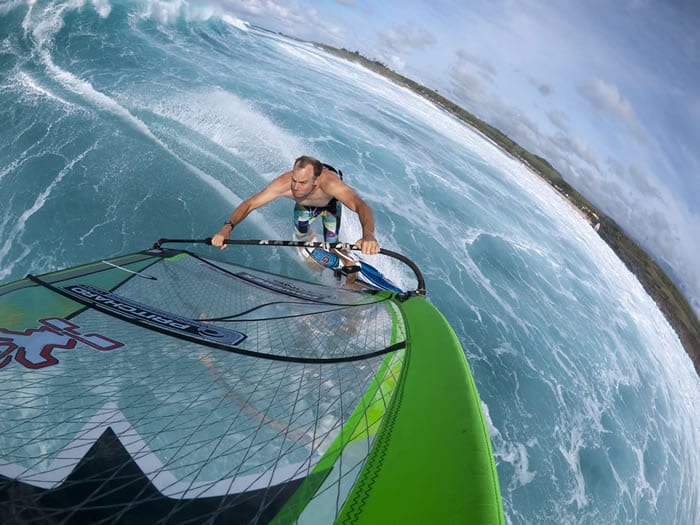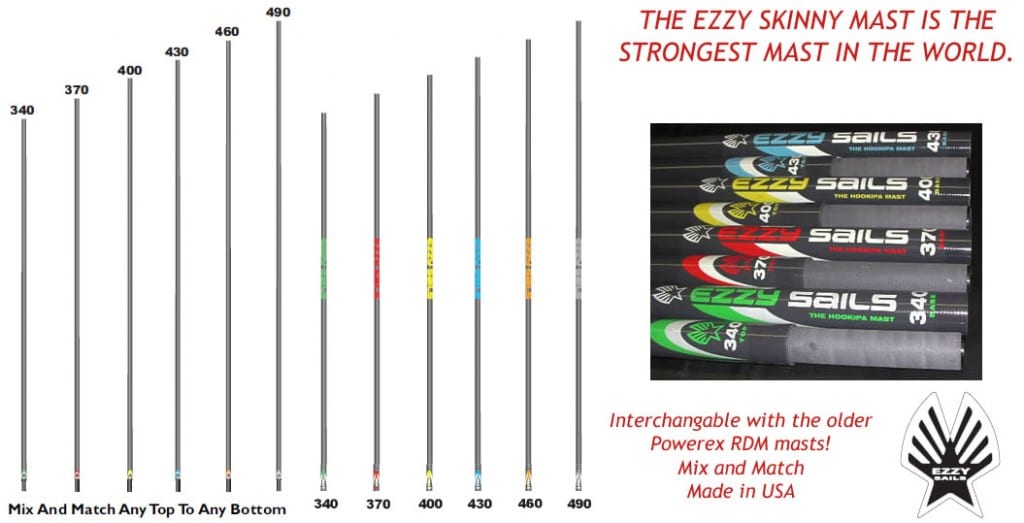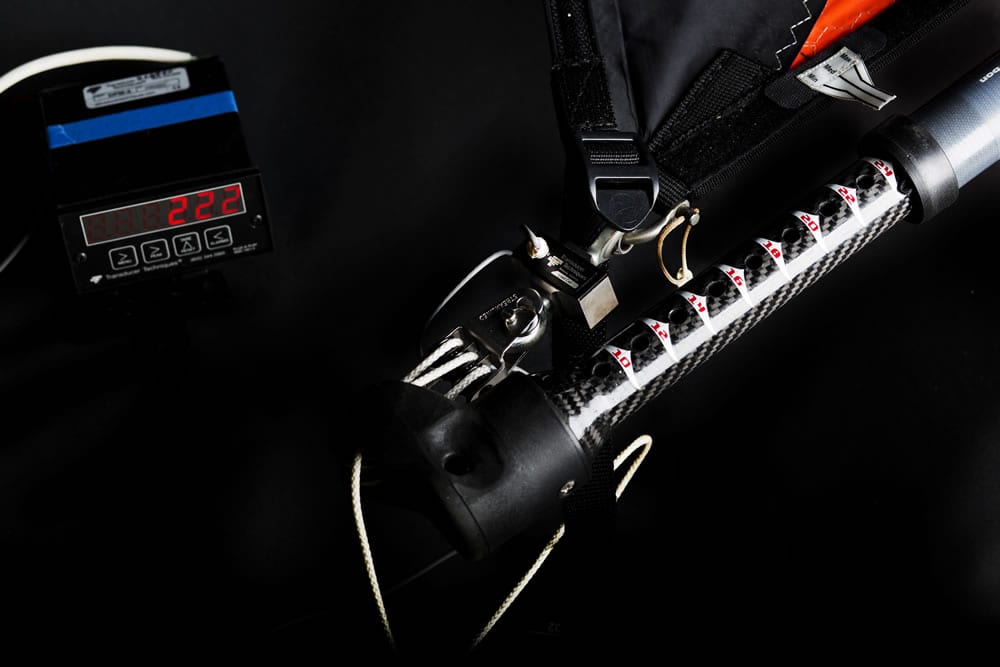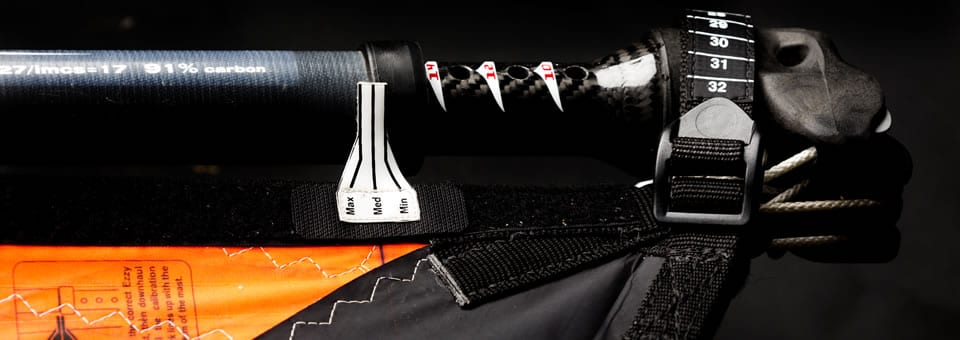Ezzy Mast FAQ’s
Is the new Legacy XT 60% carbon mast interchangeable with the Hookipa 91% carbon mast?
Yes.
Does the new 60% carbon mast work well in ALL Ezzy Sails, past and present?
Yes.
Is the bend curve and stiffness of the 60% carbon mast the same as the 91% carbon mast.
Yes.
Is the new 60% carbon mast softer than the 91% carbon mast?
No, same as the 91%.
Is the new 60% carbon mast as strong as the 91% carbon mast?
Yes.
What kind of feeling does the 60% carbon mast have compared with to the 91% carbon mast?
The 60% feels pretty good. I only notice the difference when I go back on the 91%, which still feels better to me because it is lighter.
Will you stop producing the 91% carbon masts in the future?
No. We will continue with both the 60% and the 91% masts.
Do Ezzy Sails work on SDM masts?
Yes. Ezzy sails are designed to fit on both standard diameter and reduced diameter masts.
How do I know if my non-Ezzy mast will work with Ezzy Sails?
Ezzy sails will fit on most mast brands. Some brands will work better than others. If your mast is a standard constant curve bend, it will work on our sails.
What are the bend characteristics of Ezzy Masts?
Ezzy masts have a traditional constant curve bend. Our bend curves have not changed since the early 90’s, so older sails will also work well with our masts.
What questions should I ask my shop about non-Ezzy masts (i.e. what percent bend curve and carbon content is a non-Ezzy mast I am considering).
Ask what the bend curve is. I am not referring to MCS or IMCS. I am referring to the bend characteristic of the upper and lower section relative to the middle
For a mast to work well with Ezzy Sails it should have:
¼ point = 61 to 64%
¾ point = 75 to 79%
In a nutshell, what schools of thought are out there with bend characteristics?
There are two bend curves commonly found in masts.
- Traditional constant curve, like ours: 63% base/78% tip and
- Softer bottom/stiffer tip: 65-66% base/73-75% tip
What masts brand work with Ezzy sails. Which ones don’t work so great?
Stiffer tip masts like Maui Sails, Severne and Gaastra are not the best with Ezzy Sails. These masts don’t allow the sail to twist correctly. North, Pryde and most of the other brands of masts are pretty good.Tell me about the mix and match system.
Smaller sails require softer masts. This is true for all windsurfing sails. If the mast is too stiff, the sail feels “rigid and “twitchy”.Mix and Match allows you to use a shorter, more flexible bottom to get better performance and handling.
Mix and Match also helps people who are on a budget. It allows them purchase just a top or bottom to suit their sail needs.
VIEW THE MIX AND MATCH CHART HERE
How far can you push the mix and match system? Can you mix really long tip and really short bottoms together?
We suggest going up or down just one size, however a lot of our customers report that going up or down two sizes works well.In order to keep the bend curves compatible, it is important that the bottom is the same size, or shorter than the top.
Why is it important to use the Ezzy mast with the Elite?
Each sail is rigged in the factory using a load cell, a highly sensitive that measures the downhaul force. After setting the downhaul with the load cell, we affix a gauge that lines up with the bottom of the mast.
So, all the customer has to do is downhaul until the gauge lines up with the bottom of the mast.
This system only works if the mast is the same length and bend curve as our masts. Masts from other brands are not always the correct length and may have different bend curves.
VIEW THE EZZY ELITE MAST INFO HERE
Is it really worth getting an Ezzy mast, or can I get by with what I have with the Elite?
If you have an older Powerex skinny, you might be okay, as long as the length is correct.
It is hard to tell with all of the other brands, some might be okay and some not. If the length is correct and the bend curve and stiffness is correct, it should work in the Elite.
The Elite does have visual downhaul indicators that will help you set the downhaul for non-Ezzy masts.
If I don’t want to get new masts, which sails in your collection are most accommodating to other non-Ezzy masts?
Why should I buy an Ezzy Mast?
- Works perfectly with Ezzy Sails and most other sail brands.
- Incredibly strong, will last 20 years or more.
- Mix and Match system
- Excellent warranty
- Great track record. We were the first sail company to sell a skinny mast. We launched the Ezzy skinny mast in 1999.
What does MCS and IMCS stand for?
MCS stands for Mast Check System.The MCS number tells how stiff a mast is.
The MCS is obtained by supporting the mast 5.0cm in from either end and hanging a 30 KG weight in the center of the mast. The maximum deflection is measured and divided into the length of the mast. That means a 520 mast with an MCS of 27, bends 19.26 cm when 30 KG of weight is suspended from the center. So, the higher the MCS number, the stiffer the mast. The problem with the MCS number is that it is specific to masts of the same length only. A 460 with an MCS of 25 is stiffer than a 400 with an MCS of 25.
IMCS stands for Indexed MCS.
It allows you to compare the stiffness of masts of different lengths. In effect, the IMCS is saying, if you stretched (or shrunk) your mast to a 460, this is what the MCS would be. That’s why a 430 with an MCS of 25, has an IMCS of 21. And that’s also why a 460 has an MCS of 25 and an IMCS of 25.
In case you are interested, here is how you calculate IMCS:
IMCS = (mast length)^3 / (midpoint) x 460^2
The IMCS and the MCS only tell part of the story. It does not tell anything about the bend curve. To describe the bend curve, you divide the 1/4 point deflection into the midpoint deflection and come up with a percentage. You do the same for the 3/4 point. The 1/4 point and the 3/4 points are half way from the midpoint to the bottom and halfway from the midpoint to the top respectively.




